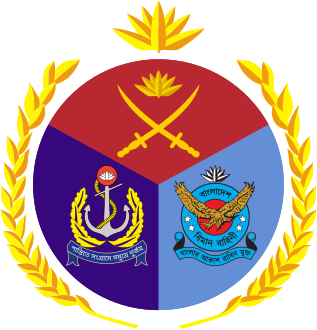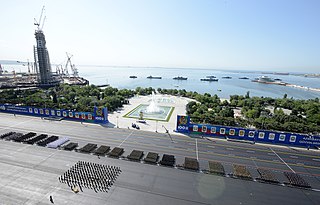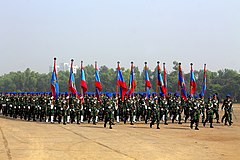
The Bangladesh Armed Forces consists of the three uniformed military services of Bangladesh: the Bangladesh Army, the Bangladesh Navy and the Bangladesh Air Force. Armed forces falls under the jurisdiction of Defence Ministry. The Border Guard Bangladesh and Bangladesh Coast Guard are under the jurisdiction of the Ministry of Home Affairs during peacetime, but during wartime they fall under the command of Bangladesh Army and Bangladesh Navy respectively.

A military parade is a formation of soldiers whose movement is restricted by close-order manoeuvering known as drilling or marching. The military parade is now almost entirely ceremonial, though soldiers from time immemorial up until the late 19th century fought in formation. Massed parades may also hold a role for propaganda purposes, being used to exhibit the apparent military strength of a country.

Many nations around the world observe some kind of Armed Forces Day to honor their military forces. This day is not to be confused with Veterans Day or Memorial Day.

The Bangladesh Army is the land warfare branch and the largest component of the Bangladesh Armed Forces. The primary mission of the Army is to provide necessary forces and capabilities to deliver the Bangladeshi government's security and defence strategies and defending the nation's territorial integrity against external attack. Control of personnel and operations is administered by the Army Headquarters, Dhaka. The Bangladesh Army is also constitutionally obligated to assist the government and its civilian agencies during times of domestic national emergency. This additional role is commonly referred to as "aid to civil administration".

Muhammad Ataul Goni Osmani, also known as Bongobir, was a Bengali military leader. He served as Commander-in-chief of Bangladesh Forces during the 1971 Bangladesh War of Independence. Osmani's career spanned five decades, beginning with service in the British Indian Army in 1939. He fought in Burma during World War II. After the partition of India in 1947, he joined the Pakistan Army and served in the East Bengal Regiment. He left the Pakistan Army as a colonel in 1967. Osmani joined the wartime Government of Bangladesh in 1971 as its chief military commander. He is regarded as the founder of the Bangladesh Armed Forces. After the war of 1971, Osmani retired as a four star general from the Bangladesh Army in 1972.

Armed Forces Day is observed in Bangladesh on 21 November. This signifies the day in 1971, when the members of the Bangladesh army, navy and air force were officially united and launched joint operations along with the people against the Pakistan occupation forces. On 16 December 1971, the Pakistani Army of 93,000 surrendered to the allied forces of Bangladesh Forces and Indian Army, ending the Liberation War of Bangladesh.

The Pakistani Instrument of Surrender was a written agreement that enabled the surrender of 93,000 soldiers of the Pakistan Armed Forces Eastern Command on 16 December 1971, thereby ending the Bangladesh Liberation War and the creation of the nation of Bangladesh.
The Bangladesh Liberation War started on 26 March 1971 and ended on 16 December 1971. Some of the major events of the war are listed in the timeline below.

The Bastille Day military parade, also known as the 14 July military parade, translation of the French name of Défilé militaire du 14 juillet, is a French military parade that has been held on the morning of 14 July each year in Paris since 1880, almost without exception. The parade passes down the Avenue des Champs-Élysées from Place Charles de Gaulle, centred around the Arc de Triomphe, to the Place de la Concorde, where the President stands, along with members of the Government, figures from the legislative branch, the Mayor of Paris, as well as foreign ambassadors to France.

National Independence Day is a national day in Poland celebrated on 11 November to commemorate the anniversary of the restoration of Poland's sovereignty as the Second Polish Republic in 1918 from the German, Austro-Hungarian and Russian Empires. Following the partitions in the late 18th century, Poland ceased to exist for 123 years until the end of World War I, when the destruction of the neighbouring powers allowed the country to reemerge. It is a non-working day and a flag flying day in Poland.

The Independence Day of Brazil, commonly called Sete de Setembro, is a national holiday observed in Brazil on 7 September of every year. The date celebrates Brazil's Declaration of Independence from the United Kingdom of Portugal, Brazil and the Algarves on 7 September 1822.

For more than a century the Military Parade of Chile or Great Military Parade of Chile has been a tradition within the Independence Day holidays in Chile. It is held in Santiago, Chile's O'Higgins Park on September 19 yearly in honor of the Glories of the Chilean Army with a military parade involving not just the ground forces but by the rest of the Chilean Armed Forces: the Chilean Navy, the Chilean Air Force, and the Carabineros de Chile. It is also in honor of the anniversary of the formal inauguration on that day in 1810 of the First Government Junta, which witnessed the first military parade of the independent nation at the Plaza de Armas, Santiago. It is the final act of the national independence celebrations, which are broadcast through TV and the Internet and radio.

The Moscow Victory Day Parade refers to the annual military parade of the Russian Armed Forces on Moscow's Red Square on May 9 during the Victory Day celebrations. The most important parade of those being held on May 9 is the one held on Moscow's Red Square, with the President of Russia as the guest of honor and keynote speaker in virtue of his constitutional mandate as Supreme Commander of the Russian Armed Forces.
Independence Day, also known as the Fifth of July is the national independence holiday of Venezuela, marked every year on July 5 which celebrates the anniversary since the enactment of the 1811 Venezuelan Declaration of Independence, making the country the first Spanish colony in South America to declare independence. In recent years, it is also marked as National Armed Forces Day to honor the faithful service of all the serving men and women and veterans of the National Bolivarian Armed Forces of Venezuela.

Day of the Foundation of the Republic is the Republic Day and National day of the Democratic People's Republic of Korea, held on 9 September.

The Kyiv Independence Day Parade has been the main event of various celebrations of the Independence Day of Ukraine, which is celebrated annually in Kyiv on August 24.

Victory Day Parades are common military parades that are held on 9 May in some post-soviet nations, primarily Russia, Kazakhstan, Belarus, and formerly Ukraine. They are usually held to honor the traditional Victory Day holiday. In 2015, the Ukrainian government had renamed the holiday as "Victory Day over Nazism in World War II" as part of decommunization laws. However, even after the change, a vast amount of the populace still honors Ukrainian-Soviet troops who fought in World War II with traditional Victory Day celebrations.

October Revolution Day was a public holiday in the Soviet Union and other Soviet-aligned states, officially observed on November 7 from 1927 to 1990.

The Presentation of Colours is a ceremony that marks an anniversary or event in the history of a particular regiment. This involves the presentation of a new version of the regimental colour to a regiment or equivalent formation in the armed forces. This is a traditional ceremony that was pioneered by the British Armed Forces, and is today used in most Commonwealth countries.

The National Day Parade, officially the National Day of the People's Republic of China Parade, is a civil-military parade event held at Tiananmen Square in Beijing, the capital of the People's Republic of China, on the National Day of the People's Republic of China on 1 October. It is organized by the People's Liberation Army, the People's Armed Police and the Militia, as well as civilian groups of the Chinese Communist Party (CCP). It has been held every decade since 1959, annually from 1950 to 1959, and has been broadcast live on China Central Television since 1984.



























